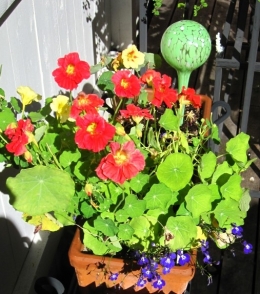Design
My Sister’s New Garden
My sister’s new garden is nestled within hilly SW Portland. It is compact and lush. I didn’t realize you could harbor such variety and fullness in a small space. Chalk it up to my sister’s sense of order and tidiness.
Meandering nasturtiums splay over the edge of the patio. They thrive on the concrete’s radiant heat.
A curvy flagstone path wends into the back corner, as if there were more to see just around the bend. Crocosmia has nearly finished blushing scarlet; a few sunflowers reach skyward (why aren’t the centers going black, she wants to know).
In their midst stand gayfeather (liatris spicata) and a staked tomato!
The piece de resistance anchors the back wall – two significant clumps of bamboo confined to an elegant wood planter she purchased up the coast. It is both an appreciation of things past and a recognition of bamboo’s beauty constrained by reality: you don’t want these aggressive grasses overrunning your main garden.
My sister tends her new garden with care and delight. Whimsey and prudence. Premeditation and pluck.
The first thing she installed was the incandescent string of lights vining the translucent, shed-like roof over the sitting area, which is the perfect place for enjoying the flora while reading, writing, sipping – or, finding a brother savoring Sauvie Island Blueberries with Barbados Cream. Heaven.
May Tidings
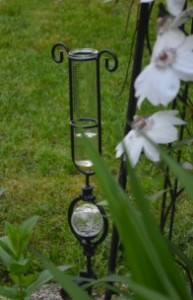
My new rain gauge near the clematis
How Dry I Am
Kate and Ryan gave me a rain gauge for my birthday. How neat. I like that it measures my rain in my yard – no more looking up our regional rainfall in the Boston Globe. I’m empowered!
Our friends, Grace and Jerry, went a step further and installed a sophisticated electronic weather monitoring system. It required them to scale heights to attach an anemometer onto their roof. I’m not there yet.
We have a winner
Also for my birthday I was gifted with a lottery ticket. It delivered me $100! I purchased with the proceeds a new white flowering dogwood (cornus florida) and heaved it into the earth close by our cherished, but aging, same variety dogwood that so beautifully graces the yard in April and May. Mild winters provide a bountiful spring bloom and there is nothing more special than that tree in our garden. Hence, adding a new generation before the old one passes.
Tick Smarts
I recently joined the Arnold Arboretum and attended a lecture there on Thursday, May 17 called “More Ticks in More Places” presented by Dr. Thomas Mather from the University of Rhode Island Tick Encounter Resource Center (tickencounter.org). Smart guy. Massachusetts and Rhode Island are the epicenter for deer tick-borne Lyme disease. It’s worth looking at his excellent website for all tick-related concerns.
Also, there’s a new tick approaching from our south called Lone Star tick – Long Island and New Jersey are already infested; it carries Rocky Mountain Spotted Fever. Fun.
As a result, I’m in the market for permethrin treated clothing and we just renewed Daphne’s “Evolution” treatment. He covered so much – dispelling myths, top ten things everyone should know, personal protection measures, safe removal, etc. Tip: after you come in from outdoor activity, throw clothes in the dryer first, then the wash. Ticks die in dry heat, but may survive washing.
A Man’s Home Is His Castle
Prepping for our golden years, we’ve begun a comprehensive house renewal program. New shingled roof, replaced worn and weathered trim boards/sills, created a portico (!) over the front door, four new windows, and new stoop and replaced cedar shingles on the back of the house. Son-in-law Ryan Flynn (yes, that Ryan Flynn) designed and crafted the portico. We’re delighted! We believe the painters will start next week. Maisy appraised our new white cedar shingles yesterday and declared: “Nice and clean!”
Midday Saturday on a beautiful May weekend. Chores. This evening we attend a performance by Coro Allegro of Rachmaninoff’s Liturgy of St. John Chrysostom at the Church of the Covenant in Back Bay.
Early Spring Dance
New England, March 2012: So odd to have late June’s cameo appearance.
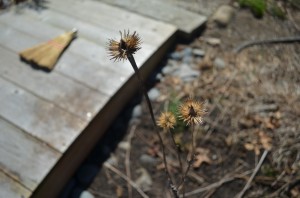
Last year's echinacea
We pensively enjoyed the abundant warmth and sunshine, while summer’s annoyances buzzed and swarmed around us, eventually driving us inside from the patio.
So many things sprang to life this week – the helleboros from Grace & Jerry, which must be thinned and would probably work better at the foot of the stone wall; our accidental hyacinth — a reliable, discarded gift from a beau to one of our teenage daughters, who are both in their 30’s now; streets bursting with magnolias already past their peak on Commonwealth Avenue, Boston; and, allergies galore.
I began clearing last year’s garden refuse and I re-installed the garden foot bridge on reset brick footings that lower the leading edge of the bridge so it’s neatly flush with the adjoining patio. This fundamental satisfaction I will enjoy forever. On walks at Humarock Beach I’m harvesting tumbled, black stones to supplement my medium hard-scape around the bridge; I will place the rounded rocks such that they become a Zen garden-like flow.
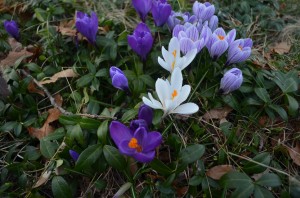
Crocus cast in myrtle
It’s too early to put out my little water feature because here in New England, in March or April, a sudden freeze can descend at any time. One doesn’t put out one’s tomatoes before Mother’s Day. My wish is for a brief cold snap to kill off the flying insects that hatched prematurely, then, a long, drawn out spring with just the right amount of rain. We can have the most spectacular Mays and Junes.
Spring is planning and planting and visioning and acting. Who knows how this season will progress? Is the sudden warmth a friendly lark or a portent of grave weather to come? Neither, both.
Herbs – the spice of life
When late afternoon arrives in our patch of yard, we turn on the reading lights. That’s because we live in dappled shade and shadows from our forested northeastern exposure. 1/2 block away it’s full sun, while we’re calling it a day.
One outcome of our scant daylight is we don’t grow food, or anything else that requires full sun. Which is OK by me because my short stint as a food grower was neither a personal or agricultural success.
Consumers are people, too
I support the concept of growing your own nutrition, but I do not support the worry: fungus, beetles, blight, cut worms, watering, fertilizing, weeding, thinning, fencing and harvesting gallons of one thing (I hope you like squash, dear). And then, it starts again next year. From scratch.
Do I lack intestinal fortitude? No, I just can’t tolerate the suspense of bringing in a crop. I gladly shop for local produce. Just leave me to my perennials.
Best of both worlds
I designed my garden for other senses – mind, eye, nose
– outdoor spaces, fragrant offerings, inspiring creations, intriguing curves, mini-vistas and low maintenance. OK, I pamper the roses a bit. Everything else weathers; a planting survives and thrives or … succumbs. Perennial pragmatism.My one exception: herbs and annuals in pots. I hate buying fresh mint at the supermarket. Ditto parsley, sage rosemary and thyme, invariably expensive or trucked from Mexico. In pots, these herbs unfailingly just grow, and without fuss — my kind of crop! They satisfy my gardening principles while providing a culinary and aesthetic je ne sais quoi.
Besides the flavor-your-food value of herbs, groupings of pots in different shapes and sizes partition and highlight an area, add graceful greenery / vivid accents, and blend practical herbs with vibrant annuals (my fave – nasturtium with lobelia). Pots of varying sizes, habitats and materials punctuate my external rooms.
I have a few herbal and non-herbal relics that winter over — bits of this and that: liatris spicata, lamium “White Nancy”, dicentra, ferns. Even my potted oregano returns each year and mint, running freely in the perennial beds, is rampant. While they do not survive Zone 6A winter, I’ve harvested parsley in late December and rosemary in January. First frost does in the basil – it’s known as a tender perennial.
Terracotta and Not
I use both clay pots and plastic pots. Classic terracotta (literally baked earth, unglazed clay) is porous, warm and weathered. Saucers under the clay pots extend the watering effect. Plastic scores lower for aesthetics but meets the low maintenance requirement because it conserves moisture much better than terracotta. That means less stress on the plants and less work for me.
I’ve taken to the heavily glazed, gigantic earthenware pots from Vietnam. They conserve water, do not crack like terracotta and make a bold statement that anchors a grouping of smaller pots. Filled with soil, they stay put!
Global watering
For pots that need chronic watering, I discovered a remedy that works pretty well — the glass watering globes that you fill with water and stick into the potted soil.
In the past I had tried mixing in the gelatinous granules (polymers) that soak up water and then release it to the plants. It’s a clever idea that doesn’t work well. Mostly the granules expand beyond reason, force the soil out of the pot, and don’t deliver much water to the roots of your potted plants. My experience is supported by research.Food for Thought
While my aesthetic vision continues to conjure up garden designs, I find joy in snipping fresh rosemary, basil, and perennial mint into my cuisine, or pinching a spicy nasturtium flower to decorate dinner. It’s another way I delight my soul.
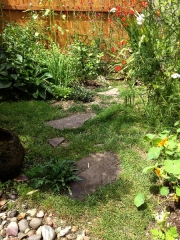
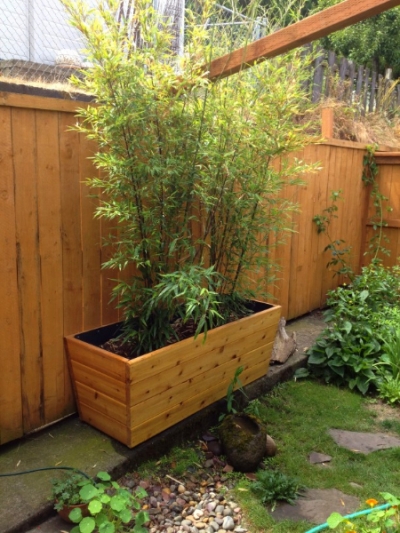
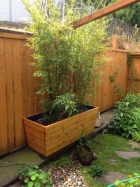
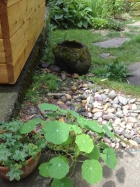




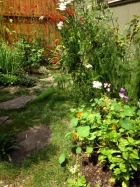



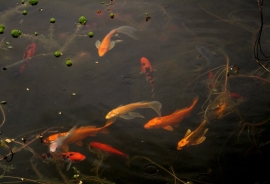
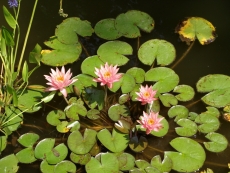
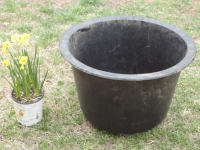
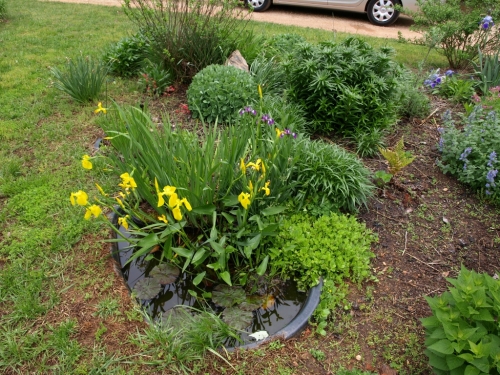
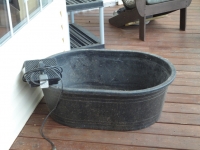
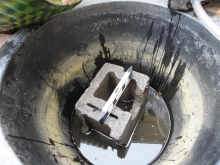

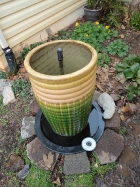 Level the pot for the best overflow
Level the pot for the best overflow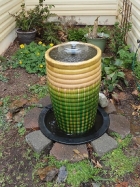 Fountain in action
Fountain in action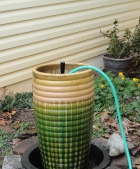 Fill the pot and basin with water
Fill the pot and basin with water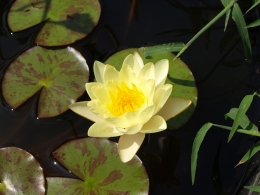

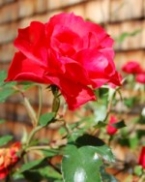
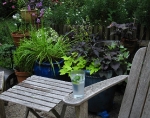 pots-with-chair
pots-with-chair potted-herbs-annuals
potted-herbs-annuals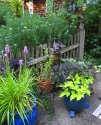 pots-with-chair2
pots-with-chair2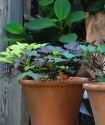 pots-sweetpotato
pots-sweetpotato